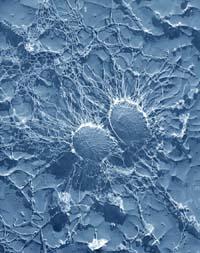The new antibiotic, an uncertain future
2006/07/02 Rementeria Argote, Nagore - Elhuyar Zientziaren Komunikazioa

Researchers have shown optimism with the discovery of platensimicine. No wonder, since it is possible to solve a serious problem with this new antibiotic: the problem of bacteria resistant to ntibiotics.
In fact, it kills bacteria from hospitals resistant to other antibiotics, such as Staphylococcus aureus.
An enzyme in fate

Staphylococcus aureus is a bacterium very concerned about hospitals, since most antibiotics do not affect it: it is resistant. (Photo: FDA)
The strategy that platensimycin uses to kill this type of bacteria is that the bacteria are not able to produce fat membranes. This blocks an enzyme (FabF). This enzyme is involved in the production of fatty acids from the bacteria and, because of the antibiotic, the bacteria cannot make new membranes or repair the damaged ones. So the bacteria die.
There are two other antibiotics with a similar strategy of killing bacteria, triclosana and isoniazid. However, in general, antibiotics use other strategies that make it difficult to produce proteins, cell walls, or DNA. Several bacteria have created resistance to these strategies. Some strains of gonococcal bacteria, for example, are not affected by conventional treatment (tetracycline and antibiotic penicillins). In turn, Staphylococcus aureus, which extends through hospitals, has developed resistance to various antibiotics using conventional strategies.
Therefore, it is noteworthy that the strategy used by the new antibiotic is novel for bacteria. Probably, strategy is the key to the success of this new antibiotic.
A long and difficult road

In this sense, the laboratory has proven that the antibiotic is effective. But there is still much to go to the market. The truth is that it is about to see if it will hit the market. And they will have to make a big investment in Mercedes.
First, they should perform clinical tests. So far the antibiotic has been tested with mice in the laboratory, and although as indicated the results have been satisfactory, it is possible that in the human body the response to bacteria is not the same, for example because it is not stable. They will have to do tests with humans, and these clinical tests are expensive and last a long time.
Despite the overcoming of all these tests, it is possible that bacteria develop their resistance shortly after marketing the antibiotic and that the antibiotic loses effectiveness. It would not be the first time an antibiotic is taken out and a few weeks later it stops producing because it is no longer effective.
If this happens, drug manufacturers would have no benefits. So many chopped works! Therefore, it has many obstacles on the way. But despite the obstacles, Merck researchers have said they intend to move forward.
Published in 7K.



